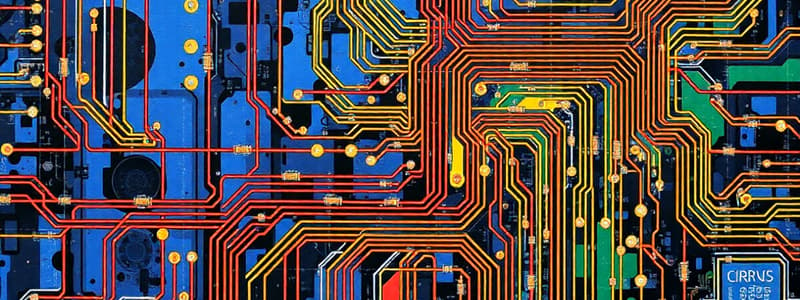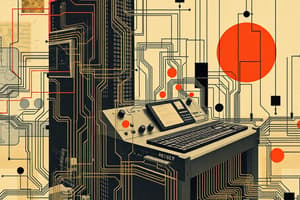Podcast
Questions and Answers
What defines the state of a sequential circuit at any given time?
What defines the state of a sequential circuit at any given time?
- The stored binary information in storage elements (correct)
- The feedback from external systems
- The last outputs only
- The current inputs only
Which of the following statements is true for asynchronous sequential circuits?
Which of the following statements is true for asynchronous sequential circuits?
- Events can occur without synchronization. (correct)
- They always produce stable outputs.
- Their behavior depends on clock cycles.
- They require synchronization through clock pulses.
What primarily differentiates sequential circuits from combinational circuits?
What primarily differentiates sequential circuits from combinational circuits?
- Sequential circuits operate faster than combinational circuits.
- There are no storage elements in sequential circuits.
- Sequential circuits have more inputs.
- They depend on past outputs as well as present inputs. (correct)
What is a characteristic of synchronous sequential circuits?
What is a characteristic of synchronous sequential circuits?
What is a disadvantage of asynchronous sequential circuits?
What is a disadvantage of asynchronous sequential circuits?
In a sequential circuit, how is the next state of the storage elements determined?
In a sequential circuit, how is the next state of the storage elements determined?
Which of the following is NOT a feature of sequential circuits?
Which of the following is NOT a feature of sequential circuits?
What is one disadvantage of a ripple counter compared to a synchronous counter?
What is one disadvantage of a ripple counter compared to a synchronous counter?
How does a D-type counter increment its count?
How does a D-type counter increment its count?
What characteristic differentiates a synchronous counter from a ripple counter?
What characteristic differentiates a synchronous counter from a ripple counter?
What is a common application of counters in digital systems?
What is a common application of counters in digital systems?
Which approach is typically used to ensure a D-type binary counter resets at maximum count?
Which approach is typically used to ensure a D-type binary counter resets at maximum count?
What distinguishes a latch from a flip-flop?
What distinguishes a latch from a flip-flop?
What are the states of the outputs Q and Q' in a flip-flop?
What are the states of the outputs Q and Q' in a flip-flop?
Which statement about the system clock in synchronous sequential circuits is correct?
Which statement about the system clock in synchronous sequential circuits is correct?
What is an undefined condition in a flip-flop?
What is an undefined condition in a flip-flop?
How does an S-R flip-flop typically maintain its state?
How does an S-R flip-flop typically maintain its state?
In a bistable multivibrator, what happens when a positive signal is applied to the Reset input?
In a bistable multivibrator, what happens when a positive signal is applied to the Reset input?
What is true regarding NAND gates in the context of constructing a flip-flop?
What is true regarding NAND gates in the context of constructing a flip-flop?
Which of the following is NOT a type of flip-flop discussed?
Which of the following is NOT a type of flip-flop discussed?
What role do inverters play in the fundamental circuit of latches?
What role do inverters play in the fundamental circuit of latches?
What is the output of the flip-flop when both inputs S and R are 0?
What is the output of the flip-flop when both inputs S and R are 0?
What happens when S = 1 and R = 0 in a flip-flop?
What happens when S = 1 and R = 0 in a flip-flop?
In the condition where both S and R are 1, what occurs in the flip-flop?
In the condition where both S and R are 1, what occurs in the flip-flop?
What effect does applying a LOW clock input have on the state of a clocked S-R flip-flop?
What effect does applying a LOW clock input have on the state of a clocked S-R flip-flop?
What is the result when S = 0 and R = 1 in a flip-flop?
What is the result when S = 0 and R = 1 in a flip-flop?
Which condition requires avoiding simultaneous application of 1s to both inputs in a flip-flop?
Which condition requires avoiding simultaneous application of 1s to both inputs in a flip-flop?
How does the clock input affect the operation of the basic flip-flop?
How does the clock input affect the operation of the basic flip-flop?
What is the condition for a J-K flip-flop to toggle its state?
What is the condition for a J-K flip-flop to toggle its state?
When both inputs of a flip-flop are 0, what happens to the output after a clock pulse is applied?
When both inputs of a flip-flop are 0, what happens to the output after a clock pulse is applied?
In a flip-flop where R returns to 0 while S remains at 0, what occurs next?
In a flip-flop where R returns to 0 while S remains at 0, what occurs next?
Which of the following represents the characteristic equation of a J-K flip-flop?
Which of the following represents the characteristic equation of a J-K flip-flop?
What is the state of a T flip-flop when T = 0 prior to a clock pulse?
What is the state of a T flip-flop when T = 0 prior to a clock pulse?
What determines the output state when an indeterminate condition arises in a flip-flop?
What determines the output state when an indeterminate condition arises in a flip-flop?
In which operation does a D-type shift register allow data to be moved?
In which operation does a D-type shift register allow data to be moved?
What happens when J = K = 0 in a J-K flip-flop?
What happens when J = K = 0 in a J-K flip-flop?
Which flip-flop configuration is best for counter design due to its toggling ability?
Which flip-flop configuration is best for counter design due to its toggling ability?
What does Qn+1 = TQ'n + T'Qn represent in a T flip-flop?
What does Qn+1 = TQ'n + T'Qn represent in a T flip-flop?
What occurs when K = 1 and J = 0 in a J-K flip-flop?
What occurs when K = 1 and J = 0 in a J-K flip-flop?
Which type of D-type shift register allows for both serial input and parallel output?
Which type of D-type shift register allows for both serial input and parallel output?
Which input conditions cause a J-K flip-flop to remain in the reset state?
Which input conditions cause a J-K flip-flop to remain in the reset state?
Flashcards
Combinational Circuit
Combinational Circuit
A logic circuit where the output depends only on the current input.
Sequential Circuit
Sequential Circuit
A logic circuit where the output depends on both current input and past outputs.
Storage Elements
Storage Elements
Devices that store binary information in sequential circuits.
Asynchronous Sequential Circuit
Asynchronous Sequential Circuit
Signup and view all the flashcards
Synchronous Sequential Circuit
Synchronous Sequential Circuit
Signup and view all the flashcards
State of Sequential Circuit
State of Sequential Circuit
Signup and view all the flashcards
Feedback Path
Feedback Path
Signup and view all the flashcards
Synchronous Sequential Circuit
Synchronous Sequential Circuit
Signup and view all the flashcards
Flip-Flop
Flip-Flop
Signup and view all the flashcards
Bistable Latch
Bistable Latch
Signup and view all the flashcards
Flip-Flop Inputs
Flip-Flop Inputs
Signup and view all the flashcards
Latch
Latch
Signup and view all the flashcards
Flip-Flop vs. Latch
Flip-Flop vs. Latch
Signup and view all the flashcards
S-R Flip-Flop
S-R Flip-Flop
Signup and view all the flashcards
Clocked Sequential Circuit
Clocked Sequential Circuit
Signup and view all the flashcards
Asynchronous Sequential Circuit
Asynchronous Sequential Circuit
Signup and view all the flashcards
S-R Flip-Flop Memory Condition
S-R Flip-Flop Memory Condition
Signup and view all the flashcards
S-R Flip-Flop Reset Condition
S-R Flip-Flop Reset Condition
Signup and view all the flashcards
S-R Flip-Flop Set Condition
S-R Flip-Flop Set Condition
Signup and view all the flashcards
Undefined Condition of S-R Flip-Flop
Undefined Condition of S-R Flip-Flop
Signup and view all the flashcards
Indeterminate Condition of S-R Flip-Flop
Indeterminate Condition of S-R Flip-Flop
Signup and view all the flashcards
Clocked S-R Flip-Flop
Clocked S-R Flip-Flop
Signup and view all the flashcards
Clock Pulse Effect in Clocked S-R Flip-Flop
Clock Pulse Effect in Clocked S-R Flip-Flop
Signup and view all the flashcards
Clocked S-R Flip-Flop in Conditional States
Clocked S-R Flip-Flop in Conditional States
Signup and view all the flashcards
Synchronous Flip-Flops
Synchronous Flip-Flops
Signup and view all the flashcards
Truth Table (S-R Flip-Flop)
Truth Table (S-R Flip-Flop)
Signup and view all the flashcards
J-K Flip-Flop
J-K Flip-Flop
Signup and view all the flashcards
Toggle State (Flip-Flop)
Toggle State (Flip-Flop)
Signup and view all the flashcards
T Flip-Flop
T Flip-Flop
Signup and view all the flashcards
T flip-flop toggle
T flip-flop toggle
Signup and view all the flashcards
Characteristic Equation (Flip-Flop)
Characteristic Equation (Flip-Flop)
Signup and view all the flashcards
S-R flip-flop undefined state
S-R flip-flop undefined state
Signup and view all the flashcards
D-type Flip-Flop
D-type Flip-Flop
Signup and view all the flashcards
Shift Register
Shift Register
Signup and view all the flashcards
Serial-In/Serial-Out (SISO) Shift Register
Serial-In/Serial-Out (SISO) Shift Register
Signup and view all the flashcards
Serial-In/Parallel-Out (SIPO) Shift Register
Serial-In/Parallel-Out (SIPO) Shift Register
Signup and view all the flashcards
SIPO Shift Register
SIPO Shift Register
Signup and view all the flashcards
D-Type Counter
D-Type Counter
Signup and view all the flashcards
Ripple Counter
Ripple Counter
Signup and view all the flashcards
Synchronous Counter
Synchronous Counter
Signup and view all the flashcards
4-bit Binary Counter
4-bit Binary Counter
Signup and view all the flashcards




